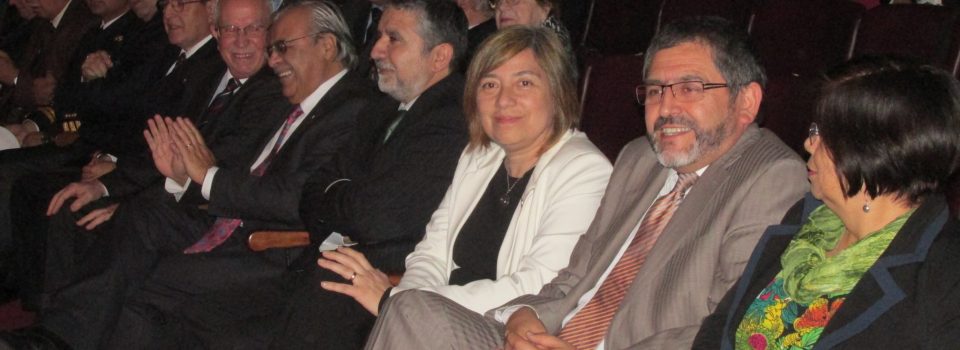IFOP actively participates at Congreso de Ciencias del Mar.
June 6th, 2016University of Concepción jointly with Sociedad Chilena de Ciencias del Mar are organizing the XXXVI Congress of Sea Sciences (2016 version), which slogan is: “Sustainability and Multidispline in Sea Sciences – SuMAR UdeC 2016.” This event will take place between May 23 and 27, at Concepción Campus, Universidad de Concepción.
The conference brings together academics, researchers and students of some Universities, Research Centers and Institutes of Chile and abroad; as well as international experts in the most emerging areas of Marine Sciences.
At the opening, Marcelo Campos Larrain, president of the Chilean Society of Marine Sciences explained that “this event has been developed interruptedly once a year since 1981, rising as the most important meeting point and platform to exchange scientific views; it is here where preferably researchers, academics and students disclose and discuss the innovations developed around marine sciences in Chile. The conclusions that annually are achieved in this Congress, are benchmarking and guidelines to focus on various actions aimed at achieving ecosystem management based on sustainability”
In the meanwhile, Leonardo Nunez, Executive Director of IFOP, said: “the active and effective presence of our researchers is very important, as this is the annual meeting of those who perform marine science and is a key space to generate agreements for transmitting knowledge, and above all, the possibility that the institute can nourish with new visions and new research strategies, and also makes possible our contribution with research of our fishing resources applied.”
IFOP presentations
Relations between the abundance of southern hake (Merluccius australis) and hoki (Macruronus magellanicus) and environmental conditions in inland waters of southern Chile, presented by Carolina Lang. One of the main fishery developed in Austral Chile is hake of the south; its spatiotemporal dynamic shows displacement from the area of channels and fjords to open ocean for reproductive purposes, affecting the abundance and availability of the resource in this area. Hydro acoustic information from cruises carried out in winter 2008 and summer 2009 at inland sea area, was utilized (acoustic density of southern hake and hoki), as well oceanographic and bathymetric data. In order to determine the effect of the variability of these bio-physical factors in the distribution of southern hake and hoki, Generalized Additive Models (GAM) were utilized. In addition, the Ripley K function was applied to determine the predator-prey interaction between southern hake and hoki, being the latter its main prey item. The results showed that the distribution of southern hake was not significantly related to physical and topographical conditions of the environment in the study area.
Morphometric comparison in veliger larva of mussel, Chilean ribbed mussel and Chilean rubbed mussel. Macarena Herrera Abaroa is the exponent of this work. This paper presents a comparison of the morphometry of the veliger larva of the mussel and from other two morphologically similar species of mytilidae present in the natural environment. The comparison was carried out using traditional morphometric analysis (valvular length and height measurements) and geometric morphometric techniques (comparison of valvular contour). The results of geometric morphometric analysis show that there is great variability in the valvular forms in each species to the same valve length.
“Spatio-temporal variability in the abundance of mytilidae larvae at areas of interest in the mytilidae culture” David Opazo presents the main results obtained in the 3 years of the Larva Mytilidae Larva Monitoring program developed by IFOP in the X and XI regions. The objective of this monitoring program is to determine the temporal variability in the supply of mytilidae larvae in several areas where the activity of mussel seed collection takes place, being this base of the production chain of mytilidae culture. The main results indicate that: (i) the supply of larvae for seed collection is highly seasonal, with the highest supply during late spring and summer in all monitored areas, (ii) among the monitored sampling stations, the ones located at Seno Reloncaví have presented the biggest supply during the 3 years of monitoring, and (iii) the supply of larvae showed a significant interannual variation in most of the monitored areas.
Symposium: “The Art, Science and the Sea.” Jacqueline Parada said “at this symposium we seek to create a forum for dialogue among scientists, artists and craftsmen, who have experienced different ways to create bridges between artistic and scientific disciplines in the area of sea science. The results of these experiences will be discussed in the context of scientific development of ideas, in the educational context and interdisciplinary training, and as scientific disclosure tool. Finally, the implications of such efforts in the study and appreciation of our marine natural heritage in Chile will be addressed.”
Variability in biomass and condition of anchovy resource, in the Chilean North Central fishery unit of Elson Leal.
On the coast of Chile, the Anchovy fishery unit (UP) (Engraulis ringens) North Central is located between 25°S-32°10’S. By using a structured and indirect evaluation model, changes in biomass and abundance in the UP north central anchovy, between 1985 and 2013 were studied. Besides, it was analyzed its condition regarding the objective Biological Point of Reference, which has been suggested in a 55% of the virgin spawning biomass. The statistical estimate incorporates information from landing, CPUE, hydro acoustic biomass, size structure, and life history parameters of the specie. The results show three periods in the variability of biomass and abundance of the resource in the area.
Temporal variability in abundance and composition of mesozooplankton in shallow areas of northern Patagonia during an annual cycle, by Patricio Mejias. Oceanographic data (temperature, salinity) and biomass of diatoms was recorded, in order to explain eventual changes in the composition and abundance of the main zooplankton groups, present in three different geographical areas: Seno Reloncaví, Inland Sea of Chiloé and Estero Pitipalena.
